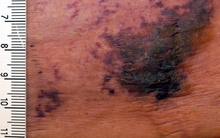| Calciphylaxis | |
|---|---|
| Other names | Calcific uremic arteriolopathy (CUA)[1] |
 | |
| Calciphylaxis on the abdomen of a person with end stage kidney disease. Markings are in cm. | |
| Symptoms | Severe pain and skin changes[1] |
| Complications | Depression, sepsis[1] |
| Causes | Unknown[2] |
| Risk factors | End-stage kidney disease, earlier stage chronic kidney disease, acute kidney injury[1] |
| Diagnostic method | Based on symptoms, skin biopsy[2] |
| Differential diagnosis | Antiphospholipid syndrome, cholesterol embolism, vasculitis, warfarin necrosis[2] |
| Treatment | Increased dialysis frequency, stopping calcium supplements, sodium thiosulfate[2] |
| Prognosis | 1 year survival < 50%[1] |
| Frequency | 4 to 400 per 10,000 on dialysis/year[2] |
Calciphylaxis is calcification of small blood vessels located within fatty tissue and the deeper layer of the skin.[1] Symptoms generally include severe pain and skin changes.[1] Often their are multiple areas of skin involvement, beginning as areas of thickening, that become purple in color, followed by the formation of an ulcer.[1] Complications may include depression and sepsis.[1]
It most commonly occurs in those with end-stage kidney disease; though can occur in earlier stage chronic kidney disease or acute kidney injury.[1] Rarely it may occur in those with normal kidney function.[1] Other risk factors include obesity, diabetes, cancer, certain medications including warfarin and vitamin D, and areas of tissue injury.[2] The underlying mechanism involves narrowing of small blood vessels followed by blood clots and the death of skin cells due to too little blood flow.[2] Diagnosis may be made based on symptoms; though can be confirmed by skin biopsy.[2]
Treatment may involved increased dialysis frequency, stopping calcium supplements, and sodium thiosulfate.[2] For those with high parathyroid hormone, cinacalcet should be used instead of activated vitamin D.[2] Other important efforts include wound care and pain management.[2] Hyperbaric oxygen therapy may help some people.[2] Outcomes are generally poor, with a typical life expectancy of less than one year.[1] The cause of death is most often sepsis.[2]
Calciphylaxis is rare, affecting about 4 to 400 per 10,000 people on dialysis per year.[2] Women are more commonly affected than men and all ages may be involved.[3] The condition was first described in 1898 by White and Bryant.[3] The importance of the condition was determined in 1976 by Gipstein.[3]
References edit
- ^ a b c d e f g h i j k l Nigwekar, SU; Thadhani, R; Brandenburg, VM (May 2018). "Calciphylaxis". New England Journal of Medicine. 378 (18): 1704–1714. doi:10.1056/NEJMra1505292. PMID 29719190.
- ^ a b c d e f g h i j k l m n Westphal, SG; Plumb, T (January 2022). "Calciphylaxis". PMID 30085562.
{{cite journal}}: Cite journal requires|journal=(help) - ^ a b c Herndon, David N. (15 June 2012). Total Burn Care E-Book: Expert Consult - Online. Elsevier Health Sciences. p. 480. ISBN 978-1-4557-3797-0. Archived from the original on 14 October 2022. Retrieved 13 October 2022.